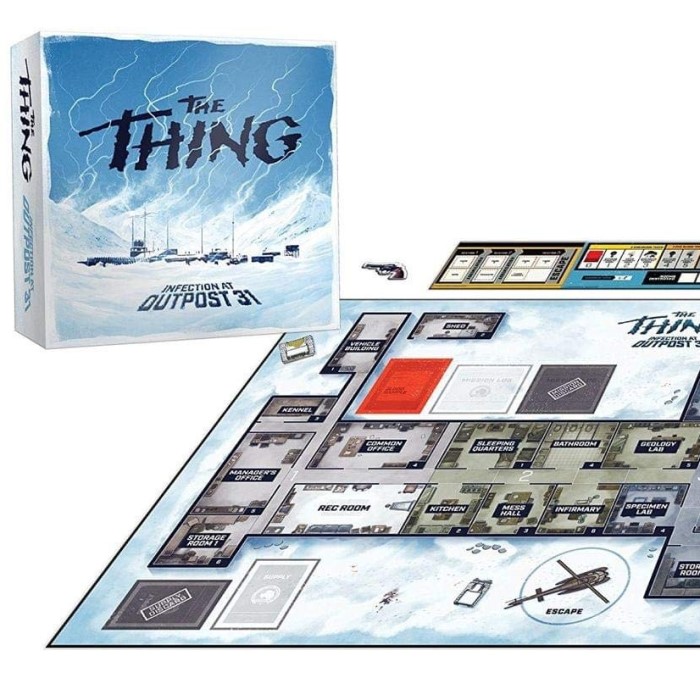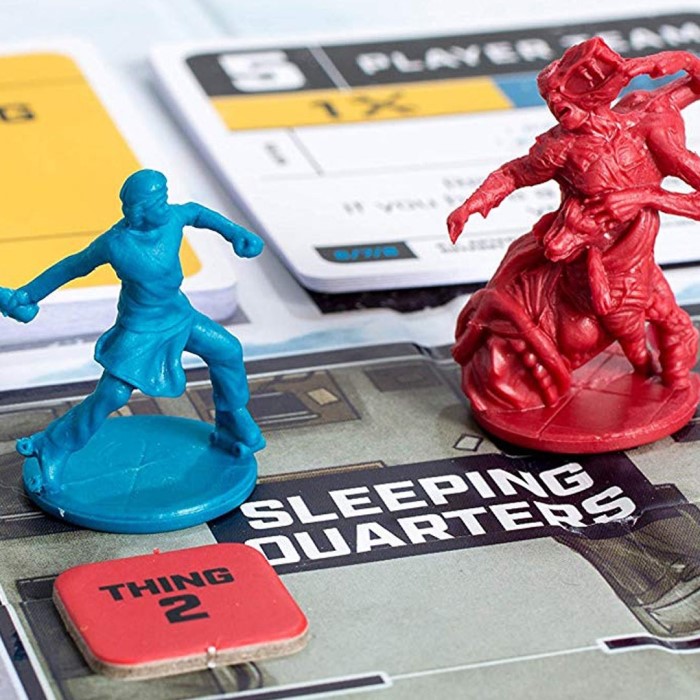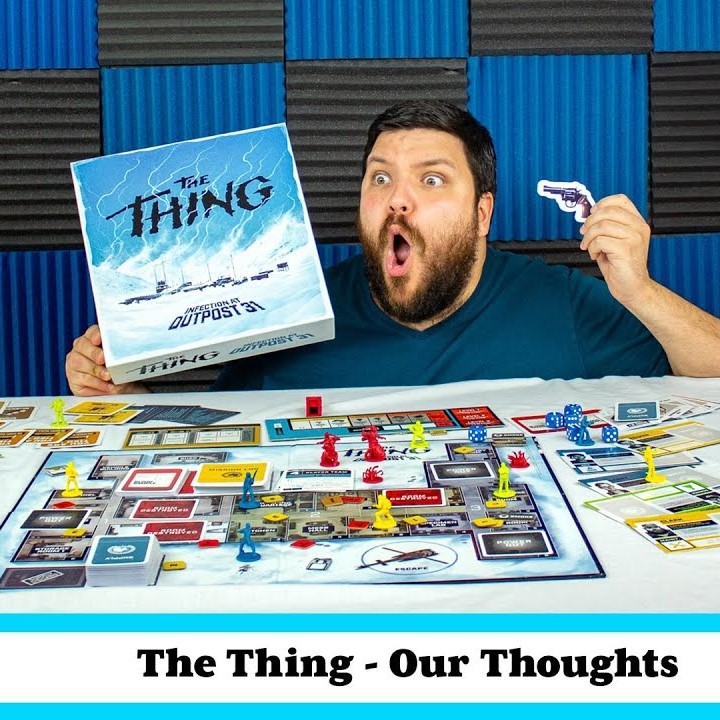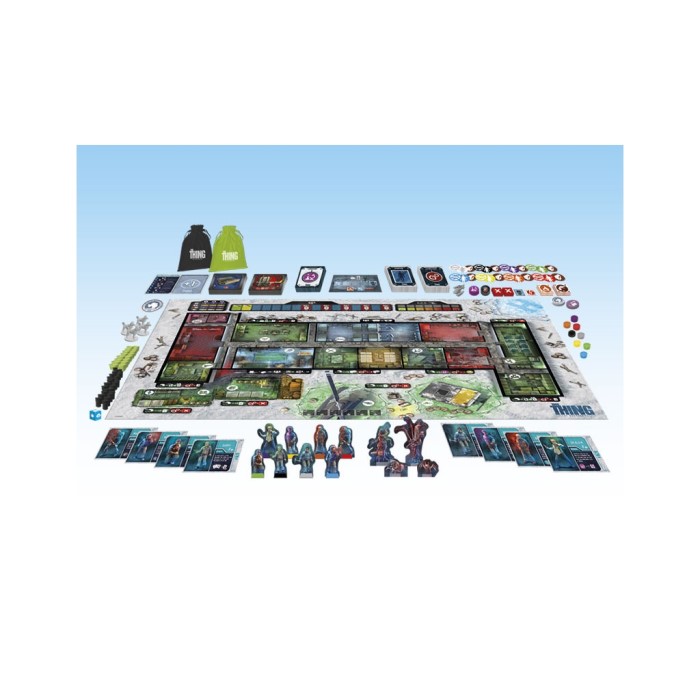Introduction
Overview and Theme of the Game
The Thing board game is a thrilling social deduction game. It is based on teamwork and deception. Players face challenges of survival in a frozen Antarctic setting. At its core are hidden identities and trust dynamics. The theme revolves around paranoia and suspicion. Each player must decide who is human and who is The Thing. Suspense, strategy, and trust make it an exciting experience.
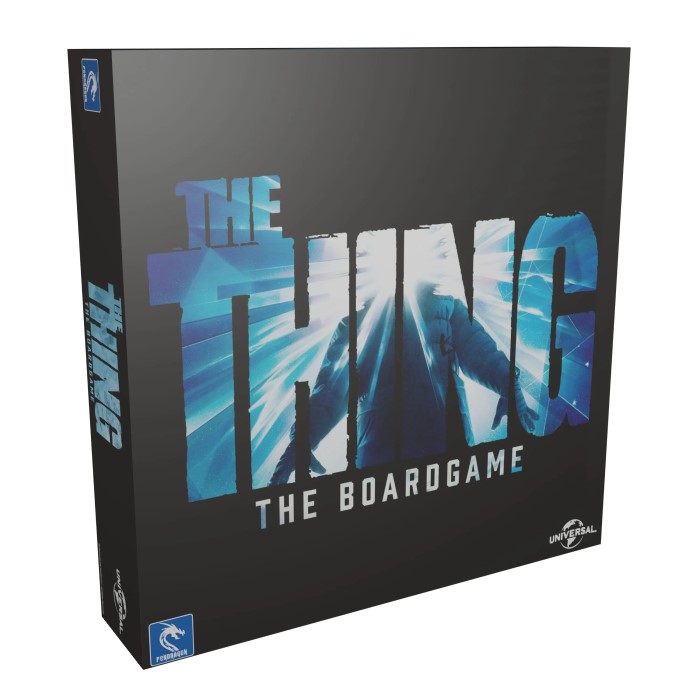
Backstory: Inspired by the Cult Classic Movie
The game draws inspiration from John Carpenter’s 1982 film “The Thing.” The movie is a horror and sci-fi classic. It tells the tale of mistrust in an isolated base. Humans battle a shape-shifting alien, disguised among them. The board game adapts this story into interactive gameplay. Players relive key movie moments through strategic decision-making and tense interactions.
Game Components and Setup
List of Included Components
When you open The Thing board game box, you’ll find several components to start the game. Here’s a complete list of what’s included:
- A game board depicting the Outpost 31 layout.
- Character cards representing players and their identities.
- Supply tokens for managing resources like food, fuel, and tools.
- Infection cards for hidden identity mechanics.
- Dice for resolving actions and events.
- Miniatures for player characters and The Thing.
- Mission logs guiding objectives.
- Petri dish tokens for infection tests.
- Rulebook explaining the gameplay.
Each component plays a key role in enhancing your gaming experience.
Setting Up the Game Step-by-Step
Follow these steps to set up The Thing board game efficiently:
- Unfold the game board: Place it in the center of the table.
- Distribute character cards: Each player selects their role.
- Prepare infection cards: Shuffle and distribute them secretly.
- Place supply tokens: Organize food, fuel, and tools in their designated areas.
- Assign starting positions: Position miniatures on the appropriate spaces.
- Set up the mission log: Place objectives near the board for reference.
- Arrange dice and Petri dishes: Make these accessible to all players.
- Read the rules aloud: Ensure everyone understands gameplay basics.
Once setup is complete, you’re ready to begin your thrilling adventure!
How to Play: Rules and Objectives
Basic Gameplay Mechanics
The Thing board game focuses on survival, deception, and teamwork. Players work together to complete missions. Each mission requires gathering resources and resolving events. Dice rolls play a key role for actions and encounters.
The game begins with secret identity cards distributed to each player. Some are humans, while others may be The Thing. Hidden identities create tension and paranoia within the group.
Players take turns performing actions, such as exploring rooms or testing for infection. Communication among players shapes the dynamics of trust and strategy. Choosing whom to cooperate with or suspect defines most decisions.
Understanding Player Roles: Humans vs. The Thing
Each player is assigned a role as either a human or The Thing. Humans aim to survive, complete missions, and uncover The Thing’s identity. The Thing, however, must secretly sabotage the group and infect others.
Humans excel at collaboration and resource management. They must carefully observe behaviors and interactions. Finding clues and tracking inconsistencies help identify The Thing. Infection tests play a key role in uncovering hidden identities.
The Thing player must stay under the radar. Their success depends on misleading others and creating distrust among humans. Strategic use of sabotage actions is crucial to disrupt missions or spread infection.
Winning Conditions and Strategies
To win, humans must fulfill mission objectives and escape Outpost 31 without The Thing spreading infection. Completing tasks and working together are essential.
The Thing wins if all humans are infected or mission failure leads to their escape. Manipulation, subtle sabotage, and influencing votes during infection tests are key strategies.
Both groups must balance risk and reward during gameplay. For humans, maintaining trust while achieving objectives ensures survival. For The Thing, blending into the group and exploiting weaknesses leads to triumph.
Key Features and Unique Gameplay Elements
Social Deduction and Trust Mechanism
The Thing board game stands out for its focus on social deduction. Players must strategically identify hidden roles. Trust is constantly tested as players aim to determine who is human and who hides as The Thing. Collaborative discussions and accusations form the heart of the gameplay. Miscommunication or intentional deception creates intense suspense. The balance between trust and paranoia keeps players engaged in every turn.
Resource Management and Survival Tactics
Survival in The Thing board game is directly tied to resource management. Players must gather and allocate supplies like food, fuel, and tools. Efficient resource use is essential for completing missions and maintaining group functionality. Decisions on resource allocation often spark group debates, increasing tension. Mismanaged resources can lead to mission failures or amplify suspicion within the group. This mechanic simulates the urgency of survival in an isolated setting.
Hidden Identity and Deception Dynamics
The hidden identity aspect is a key feature of the game. Every player starts with a secret role, either human or The Thing. The Thing must covertly spread infection while humans aim to identify and neutralize it. Successful deception often hinges on acting convincingly human. Meanwhile, humans need to recognize subtle behavioral inconsistencies. Infection tests and strategic voting further amplify the game’s tension. This dynamic creates an ongoing battle of wits and strategy.
Tips and Strategies for Success
Strategies for Humans: Cooperation and Observation
Humans must rely on teamwork and careful observation to win in The Thing board game. Here are key strategies to succeed:
- Strengthen trust through communication: Discuss suspicions openly and encourage honesty among teammates. Clear communication helps identify inconsistencies.
- Watch player behaviors: Look for unusual actions or hesitations. These may indicate someone is The Thing.
- Prioritize resource management: Ensure supplies like food and fuel are used wisely to complete missions successfully.
- Perform frequent infection tests: Use infection tests strategically to verify identities. Focus on suspicious players first.
- Share findings with the group: Organize trust circles or share insights openly. Collaboration uncovers hidden threats faster.
- Keep track of past actions: Review previous moves to catch patterns or mistakes made by The Thing.
Staying alert and working as a team improves your chances of survival and success.
Strategies for The Thing: Subtle Manipulation
As The Thing, secrecy and subtlety are your strongest allies. Use these strategies to manipulate the group effectively:
- Blend in with humans: Complete missions occasionally to avoid drawing suspicion to your role.
- Sow doubt among players: Subtly accuse others to shift suspicion away from yourself.
- Sabotage covertly: Ruin supplies or manipulate dice outcomes, but keep your actions discreet.
- Limit your infection spread: Infect others strategically but avoid drawing attention to the pattern of infections.
- Feign cooperation: Actively participate in discussions and tests to appear trustworthy.
- Exploit resource crises: Create shortages or mismanage resources to weaken the group’s mission success.
Deception and calculated moves are crucial for your victory as The Thing.
Balancing Risk and Reward During Gameplay
Balancing risks and rewards is essential for both humans and The Thing. Consider these tips:
- For humans: Carefully decide when to accuse or trust another player. Risking false accusations can harm trust.
- For The Thing: Choose when to sabotage carefully. Avoid acting suspiciously but increase tension at critical moments.
- During resource decisions: Weigh the importance of saving supplies versus completing missions.
- In infection tests: Use them wisely, as they reveal identities but can cause friction among players.
- Collaboration: While collaboration is key for humans, it can also give The Thing opportunities for sabotage.
- Trust timing: Both groups must determine whom to trust at strategic moments while assessing risks.
Effective risk-reward management can significantly shift the game’s outcome, creating a thrilling experience for all players.
Expansions and Variants
Official Expansions Available
The Thing board game has expansions that add new layers of strategy and excitement. These expansions include additional content, objectives, and characters, keeping the gameplay fresh and challenging. Here are some highlights of official expansions:
- New Locations: Some expansions introduce fresh areas to explore beyond Outpost 31. These add variety to the game’s environment.
- Additional Characters: Expansions can include extra roles with unique abilities, giving more player options.
- Enhanced Mechanics: They may also bring new rules or cards to make the gameplay more dynamic.
- Harder Challenges: Some expansions increase difficulty, offering seasoned players a tougher survival experience.
These add-ons immerse players deeper into the theme while providing new tactical opportunities. They also extend replayability, making the game enjoyable over repeated sessions.
Custom Variants and Community-Generated Rules
Fans of The Thing board game have created custom variants that modify or enhance the game. These community-generated rules allow players to tailor their experience. Here are common ideas:
- Expanded Player Roles: Fans add custom roles with unique traits or objectives, creating a more diverse gameplay experience.
- Custom Infection Rules: Some variants introduce alternative infection mechanics to heighten suspense and make deception trickier.
- Time Limit Scenarios: These versions add timed challenges to increase tension during missions.
- New Resource Systems: Players may implement unique resource rules to encourage strategic planning.
- Team-Based Objectives: Some variants divide players into smaller teams, adding an extra layer of competition.
Custom rules foster creativity and keep the game interesting for long-time players. Sharing these ideas within the player community also drives innovation, keeping The Thing board game a fan favorite.
Frequently Asked Questions (FAQs)
Common Rules Clarifications
Understanding the rules for The Thing board game ensures fair and enjoyable gameplay. Here are answers to common rule-related concerns:
- How are infection cards distributed? Begin by shuffling the infection cards. Then, secretly distribute one card to each player.
- Can The Thing infect more than one person in a round? No, The Thing infects one person per designated infecting action or event.
- What happens during a failed mission? Failed missions reduce group resources or trust. Progress slows, increasing danger to the team.
- How do infection tests work? Players use Petri dish tokens to test suspicion. These reveal if someone is infected by The Thing.
- What if players’ roles are accidentally exposed? Players may restart the game or proceed while acknowledging the exposed roles for fairness.
Clarifying these rules before gameplay avoids misunderstandings and keeps games running smoothly.
Troubleshooting Game Conflicts
Conflicts may arise during The Thing board game due to suspicion or gameplay disagreements. Here are tips for resolving them:
Differing Accusations: Approaching Suspicion Calmly
- When accusations arise among group members, it’s crucial to discuss the reasoning behind these suspicions in a calm and respectful manner. Holding a composed dialogue can help clarify misunderstandings and prevent escalation.
- Create an open environment where everyone feels comfortable voicing their concerns. Encourage players to present their arguments with supporting evidence or observations, which can foster a more robust discussion.
- Once all perspectives have been shared, let group members participate in a democratic vote to settle disputes. This voting process can help ensure that everybody feels included in decision-making, while also promoting fairness within the group.
Resource Allocation Disagreements: Prioritizing Mission Needs
- Disagreements may arise regarding the allocation of limited resources necessary for mission completion. To address this, it’s essential for the group to collaborate and prioritize the most urgent needs together.
- Start by listing all available resources and identifying which ones are critical for the immediate success of the mission. Encourage players to weigh the pros and cons of resource allocation collaboratively.
- For particularly tough choices, hold votes among the players to determine how to allocate resources. This democratic approach can help ease tensions and ensure everyone’s voice is heard in the decision-making process.
Role Misunderstanding: Clarifying with the Rulebook
- Role misunderstandings can create friction within the game, significantly impacting gameplay. When such confusion occurs, it’s advisable to reference the game’s rulebook for clarity.
- Propose a brief pause in gameplay to consult the rulebook together, ensuring everyone understands the rules governing their roles. This communal effort can reinforce group cohesion and improve overall understanding of the game mechanics.
- If disputes regarding roles persist even after consulting the rulebook, agree on a temporary compromise. For example, players can decide to play with a modified interpretation of the rules until the end of the current round.
Gameplay Pace Issues: Maintaining Flow
- It’s essential to address pacing issues to maintain an enjoyable game flow. Encourage players to focus on their individual turns and make decisions in a timely manner.
- To keep the game moving, set a time limit for turn-taking if necessary. This can help prevent prolonged discussions that may disrupt the pace of the game.
- If players begin to engage in extended discussions, gently remind them of the need to keep the gameplay flowing. Maintaining momentum is vital for sustaining the group’s engagement and enjoyment throughout the session.
Hidden Identity Disputes: Using Infection Tests
- In the event of hidden identity disputes where players strongly disagree on someone’s role, consider using infection tests as definitive proof. Infection tests can serve as an objective way to resolve these disagreements.
- Inform players that the results of the infection test will be treated as conclusive evidence regarding a player’s true identity. This can help alleviate uncertainties and clear up lingering suspicions within the group.
- When using infection tests, ensure that the process is transparent and that all players understand how the tests work. This transparency can enhance trust and foster a greater sense of fairness in resolving hidden identity disputes.
Resolving conflicts efficiently ensures everyone enjoys the suspense and strategy of The Thing board game.
Conclusion: The Thrilling Experience of The Thing Board Game
In summary, The Thing Board Game offers a rich platform for social interactions and strategic gaming. By following the outlined rules and gameplay strategies, you can engage friends in imaginative ways, creating unforgettable moments together. The combination of teamwork, deceit, and immersive themes positions this board game as a unique contender in the realm of social deduction games. Ready to dive into this exhilarating experience? Gather your friends and prepare for a night filled with suspense, laughter, and memorable achievements.
